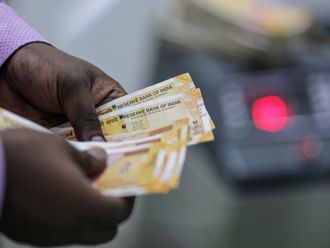Gold
Gold edged up on Friday, recovering from a decline of two percent in the previous session, propped up by physical buying interest, but ebbing investment demand in consequence of an improved economic outlook continued to weigh on prices. US home resales jumped more than expected in December and claims for new jobless claims last week posted their biggest decline in nearly a year. Investment interest in gold and silver has fallen in the beginning of the year, with holdings in the exchange-traded funds dropping to multi-month lows. Holdings in the SPDR Gold Trust remained unchanged. Holdings in the iShares Silver Trust, the world's largest gold-backed exchange-traded fund, fell further to 10,526.70 tonnes, its lowest since November. An improved economic outlook dampens gold's safe-haven appeal, but inflation worries down the road may again drive investors to the precious metal.
US dollar
The US dollar rose on Thursday as better-than-expected housing and employment data suggested the US economy was improving, though hopes Europe was getting a handle on its debt crisis limited euro selling. Worries that China will try to choke off excessive growth with higher interest rates also boosted the greenback by sparking a sharp decline in the Australian and New Zealand dollars. Australia exports natural resources to China, which makes its currency sensitive to China's economic outlook.
Euro
Among major currencies, the euro did best in holding its ground against the greenback on Thursday. Sentiment has lately favoured the single currency, with persistent demand from sovereign accounts affording euro-zone officials time to make progress on finding a sustainable solution to a debt crisis. Euro zone officials were said to be considering letting the European Financial Stability Facility, the bloc's bailout fund, purchase or help finance the purchase of government debt from troubled euro-zone nations. That has helped ease selling pressure on debt from Portugal and Spain. Technical analysis suggests that the euro's ability to rebound from a brief dip below its $1.3435 100-day moving average is a bullish sign. Investors still worry that high financing needs in Spain and Portugal could push both to seek emergency rescue funds. Ratings agency Fitch said more bailouts of the sort given to Ireland and Greece are still a high risk. But if euro zone leaders manage to get things under control, investor anxiety may shift elsewhere.
Indian rupee
The Indian rupee was on course for a third consecutive session of losses on Friday, weighed down by lower stocks and weaker regional peers. Foreign funds have sold shares worth a net $717 million this month, as accelerating inflation, slowing factory output and rising borrowing costs dampened the outlook for equities. The 30-share BSE index and the 50-share NSE index were both trading down 0.4 percent at 18,966.74 and 5,689.35 respectively. The rupee is down 2.2 percent this month. In 2010, it had strengthened 4.1 percent, helped by foreign portfolio flows of a record $29.3 billion into equities. Demand for US dollars from oil companies is expected to weigh on the rupee.
Sterling
GBP fell against the US dollar and the euro on Thursday after the greenback rallied on strong US housing numbers and some large real money accounts reallocated funds away from the pound to the single currency. Also weighing on sterling was a mixed UK industrial trends survey that highlighted the dilemma facing Bank of England policymakers. The pound has been well supported since higher-than-forecast UK inflation data on Tuesday caused investors to bring forward expectations for when the BoE will hike rates, with a 25 basis point rise fully priced in by around mid-year. However, they say market watchers are wary that a weak economy and harsh austerity measures to come mean a rate hike is not a done deal. Data on Wednesday showed UK unemployment rose at its fastest pace in 8 months in November against a backdrop of weak pay growth, while weak pay growth marginally tempered concerns about consistently high inflationary pressures.
Oil
Crude futures stayed weak on Friday, a day after a sell-off amid an unexpected rise in US crude stockpiles and worries that China might tighten monetary policy to fight inflation. US crude oil stockpiles rose 2.62 million barrels in the week to Jan. 14, defying forecasts for a 400,000 barrel drawdown, data from the US Energy Information Administration showed. China's implied oil demand surged 19 percent to a record 9.6 million barrels per day (bpd) in December, ending the year with record refining volumes and strong diesel imports to ease a domestic diesel shortage.
Source: Richcomm Global Services, DMCC, Dubai; www.richcommglobal.com
|
Price Update
|
|
|
GOLD
|
1347.6
|
|
SILVER
|
27.37
|
|
EURO
|
1.3512
|
|
GBP
|
1.5914
|
|
YEN
|
82.74
|
|
RUPEE
|
45.67
|
|
AED / INR
|
12.434
|
|
AUD
|
0.9869
|
|
CHF
|
0.965
|
|
CAD
|
0.9964
|
|
OIL - WTI)
|
89.7
|
|
|
|
|
Date
|
Jan 21, 2011
|
|
Time
|
11:22:33 AM
|











